Crossing the Pacific on the slow Hyundai from China
#1
FlyerTalk Evangelist
Original Poster
Join Date: Nov 1999
Programs: FB Silver going for Gold
Posts: 21,792
Crossing the Pacific on the slow Hyundai from China
Crossing the Pacific on the slow Hyundai from China: CMA CGM Libra from HongKong to Long Beach
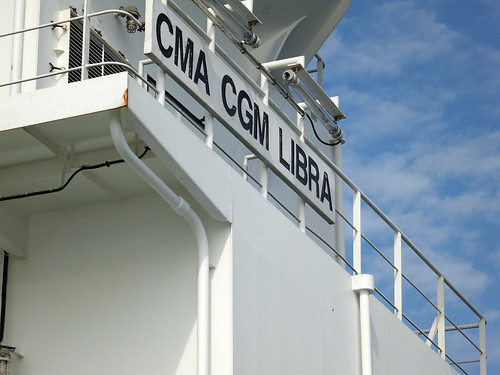 Starboard name plate
Starboard name plate
Having long reached an age where poorly-timed eastbound international flights (i.e., those that have you arriving at midnight in your home time zone) have proven hugely disruptive to my sleep pattern, I’ve always wanted to try the gradual time-adjusting method of ship travel. Unfortunately trying to use cruise ships for this purpose is generally very limiting as far as timing and routes go (e.g., trans-Pacific and Europe-Asia and are seasonally directional like migrating whales) and can be expensive as cruise lines find places to stop which serves to increase passenger desirability (and hence fares) but also to bump up port fees too. Fortunately, there is freighter travel but this is limited by the small number of ships who do offer paid passage. Having done research and having it in mind for over 20 years, I finally decided to give it a go.
Freighter travel is not new and was once a major means of intercontinental travel before the advent of the jet age as passenger steamers didn’t go everywhere, or weren’t the cheapest. Of course things have changed and the little tramp steamers and packet boats have now been replaced by container ships and we all know what passenger-carrying ships (d)evolved into.
The first challenge is finding a route where passenger travel is offered, and then the line. At least two lines I know that do offer passenger travel (Hanjin and Hamburg Süd) mention absolutely nothing on their websites. It would almost seem they regard passengers as a nuisance and their fares petty cash. CMA-CGM, for reasons to be explained, rather proudly does but has absolutely no indication of their routes.
Before we begin, some facts:
Containers – the industry
The shipping container system has become the universal mode of goods transportation to replace (or offload) loading or unloading of ships one bag, box or crate at a time. A standard container, also known as a measure of Twenty foot Equivalent Unit or TEU, is a container measuring 8’ wide, 20 long and 8 ½’ high. With the advent of larger trucks, most containers are 40’ these days with some even 45’ (which the Libra carries above deck), with some containers are also overheight at 9 1/2 ‘ with legal maximum weight of 34.8 tonnes. 48’ and 53’ containers also are used in the U.S. for rail and truck transportation (too long to be carried on a ship).
Sea freight is one of the cheapest methods of transportation, so container ships are the international trunk carriers, with further distribution by train, truck, smaller ships and barges. The vogue in North America is inter-nodal transportation where containers are double-stacked on rail carriages for transport to and from ports. Some containers may be trans-shipped by barges and small ships at either end to small ports from larger ones and vice-versa. CMA CGM has a ship of 150 TEUs to ferry containers between France and Tunisia; that capacity wouldn’t even fill the above deck space of half a hold slot on the Libra of which there are 20. Containers usually carry the logo of their shipping companies but some larger customers, such as JB Hunt (that big trucking outfit you see all over U.S. highways, and the retailer Canadian Tire (which may not ship with CMA CGM), have their own.
Containers are also used to ship perishables which are where the refrigerated container (“reefers”) are used. Essentially it is a container with an electric cooler (or freezer) built into one end and can be used to ship meats, vegetables, fruits, medicines, wine & beverages, frozen foods and a whole host of other temperature-sensitive goods. Ships have electrical outlets to power these (probably the biggest use of electrical power) and the Libra has some 800 points where reefers can be hooked up. I think that reefers originating from France at 10-15C would be the most fun to have a look inside.
The Shipping Line
The Line was formed in its current incarnation when the French government privatised its shipping entity CGM which was purchased by Jacques Saadé, a Frenchman of Lebanese origin who had founded CMA, and who has since built it up to the 3rd-largest shipping group, adding the logistics group CGM along the way.
CMA CGM ships can be found operating routes worldwide though some routes are pooled with or operated by other shipping lines. There are of course very regular sailings. From Europe to east and south Asia, South America, North America, Africa, various French possessions and territories, with the Europe-Australia route a particularly-popular passenger one. The line we are sailing is the weekly Pearl River Express which is a some 42-day rotation between east Asia ports primarily in southern China (the Pearl river is the river of GuangZhou a.k.a. Canton and its delta includes NanSha and HongKong where we boarded) and the U.S. west coast ports of Long Beach and Oakland. Another line we were supposed to have taken a ride on part of last year between Malta and Port Klang is the Columbus Loop which runs between the North American east and west coasts via Europe and Asia. With low fuel prices, the eastbound Europe stop was eliminated completely and the ships sail directly from Savannah to Port Klang. It would seem that a refuelling stop is necessary but these ships can hold enough fuel to sail for weeks.
Saadé believes that his line should carry passengers to keep the officers nice and civil (or make them that way, or try to – I can’t find the quote right now) so some 75 ships (mainly those under direct ownership/control rather than under management or acquired through mergers) of the 400+ fleet are outfitted to carry passengers. Even so, fewer than 1,000 passengers sail fleetwide annually. So this is where we find ourselves as part of this small number, not even 1/4th or 1/5th of one single, large cruise ship’s weekly load out of Fort Lauderdale. The Line had a luxury small ship cruise line, Le Ponant, but that was sold to focus on cargo.
Some say that passengers provide extra revenue to the line at very little marginal cost (other than the 2 or more employees at the Travel Department) but I wonder if the extra investment in outfitting the shape with cabins is recovered? Assuming 20-30 days of travel per passenger, extra revenue is only €2-3 million annually.
One reason I chose CMA CGM is because wine is reportedly served at lunch and dinner with the Line even having its own Château Paquebot label. As things turn out, it depends on what nationality the officer complement (“pavillon”) of your ship is. Due to E.U. mobility rules, don’t assume a ship flagged in one E.U. member country has officers from that country. French-officered ships also seem to be an increasing rarity.
 Starboard name plate
Starboard name plate Having long reached an age where poorly-timed eastbound international flights (i.e., those that have you arriving at midnight in your home time zone) have proven hugely disruptive to my sleep pattern, I’ve always wanted to try the gradual time-adjusting method of ship travel. Unfortunately trying to use cruise ships for this purpose is generally very limiting as far as timing and routes go (e.g., trans-Pacific and Europe-Asia and are seasonally directional like migrating whales) and can be expensive as cruise lines find places to stop which serves to increase passenger desirability (and hence fares) but also to bump up port fees too. Fortunately, there is freighter travel but this is limited by the small number of ships who do offer paid passage. Having done research and having it in mind for over 20 years, I finally decided to give it a go.
Freighter travel is not new and was once a major means of intercontinental travel before the advent of the jet age as passenger steamers didn’t go everywhere, or weren’t the cheapest. Of course things have changed and the little tramp steamers and packet boats have now been replaced by container ships and we all know what passenger-carrying ships (d)evolved into.
The first challenge is finding a route where passenger travel is offered, and then the line. At least two lines I know that do offer passenger travel (Hanjin and Hamburg Süd) mention absolutely nothing on their websites. It would almost seem they regard passengers as a nuisance and their fares petty cash. CMA-CGM, for reasons to be explained, rather proudly does but has absolutely no indication of their routes.
Before we begin, some facts:
Containers – the industry
The shipping container system has become the universal mode of goods transportation to replace (or offload) loading or unloading of ships one bag, box or crate at a time. A standard container, also known as a measure of Twenty foot Equivalent Unit or TEU, is a container measuring 8’ wide, 20 long and 8 ½’ high. With the advent of larger trucks, most containers are 40’ these days with some even 45’ (which the Libra carries above deck), with some containers are also overheight at 9 1/2 ‘ with legal maximum weight of 34.8 tonnes. 48’ and 53’ containers also are used in the U.S. for rail and truck transportation (too long to be carried on a ship).
Sea freight is one of the cheapest methods of transportation, so container ships are the international trunk carriers, with further distribution by train, truck, smaller ships and barges. The vogue in North America is inter-nodal transportation where containers are double-stacked on rail carriages for transport to and from ports. Some containers may be trans-shipped by barges and small ships at either end to small ports from larger ones and vice-versa. CMA CGM has a ship of 150 TEUs to ferry containers between France and Tunisia; that capacity wouldn’t even fill the above deck space of half a hold slot on the Libra of which there are 20. Containers usually carry the logo of their shipping companies but some larger customers, such as JB Hunt (that big trucking outfit you see all over U.S. highways, and the retailer Canadian Tire (which may not ship with CMA CGM), have their own.
Containers are also used to ship perishables which are where the refrigerated container (“reefers”) are used. Essentially it is a container with an electric cooler (or freezer) built into one end and can be used to ship meats, vegetables, fruits, medicines, wine & beverages, frozen foods and a whole host of other temperature-sensitive goods. Ships have electrical outlets to power these (probably the biggest use of electrical power) and the Libra has some 800 points where reefers can be hooked up. I think that reefers originating from France at 10-15C would be the most fun to have a look inside.
The Shipping Line
The Line was formed in its current incarnation when the French government privatised its shipping entity CGM which was purchased by Jacques Saadé, a Frenchman of Lebanese origin who had founded CMA, and who has since built it up to the 3rd-largest shipping group, adding the logistics group CGM along the way.
CMA CGM ships can be found operating routes worldwide though some routes are pooled with or operated by other shipping lines. There are of course very regular sailings. From Europe to east and south Asia, South America, North America, Africa, various French possessions and territories, with the Europe-Australia route a particularly-popular passenger one. The line we are sailing is the weekly Pearl River Express which is a some 42-day rotation between east Asia ports primarily in southern China (the Pearl river is the river of GuangZhou a.k.a. Canton and its delta includes NanSha and HongKong where we boarded) and the U.S. west coast ports of Long Beach and Oakland. Another line we were supposed to have taken a ride on part of last year between Malta and Port Klang is the Columbus Loop which runs between the North American east and west coasts via Europe and Asia. With low fuel prices, the eastbound Europe stop was eliminated completely and the ships sail directly from Savannah to Port Klang. It would seem that a refuelling stop is necessary but these ships can hold enough fuel to sail for weeks.
Saadé believes that his line should carry passengers to keep the officers nice and civil (or make them that way, or try to – I can’t find the quote right now) so some 75 ships (mainly those under direct ownership/control rather than under management or acquired through mergers) of the 400+ fleet are outfitted to carry passengers. Even so, fewer than 1,000 passengers sail fleetwide annually. So this is where we find ourselves as part of this small number, not even 1/4th or 1/5th of one single, large cruise ship’s weekly load out of Fort Lauderdale. The Line had a luxury small ship cruise line, Le Ponant, but that was sold to focus on cargo.
Some say that passengers provide extra revenue to the line at very little marginal cost (other than the 2 or more employees at the Travel Department) but I wonder if the extra investment in outfitting the shape with cabins is recovered? Assuming 20-30 days of travel per passenger, extra revenue is only €2-3 million annually.
One reason I chose CMA CGM is because wine is reportedly served at lunch and dinner with the Line even having its own Château Paquebot label. As things turn out, it depends on what nationality the officer complement (“pavillon”) of your ship is. Due to E.U. mobility rules, don’t assume a ship flagged in one E.U. member country has officers from that country. French-officered ships also seem to be an increasing rarity.
Last edited by YVR Cockroach; Jun 19, 2016 at 3:40 pm
#2
FlyerTalk Evangelist
Original Poster
Join Date: Nov 1999
Programs: FB Silver going for Gold
Posts: 21,792
Part II
The ship
 Built by Hyundai by yvrcockroach, maybe even made of old Ponys and Excels
Built by Hyundai by yvrcockroach, maybe even made of old Ponys and Excels
Simply put, the CMA CGM Libra is huge, as are her 8 sister ships. Built by Hyundai and delivered in 2010, she is just about 364m (1,200’) long, 45.6m (150’) wide with a draft of some 15.5m and rated at 11,388 TEUs, though that is almost half the size of the newest container ships (additions to the CMA CGM fleet since include the newly-delivered China-built CMA CGM Benjamin Franklin (~18,000 TEUs) with CMA CGM Kerguelen and Georg Forster (above 17,000 TEU) and CMA CGM Marco Polo, Alexander von Humboldt and Jules Verne (16,000 TEUs), all of which have been delivered in the past 3 years. Some in the Maersk Line are even larger.
Despite her mid size, the Libra is as long as the world's largest cruise ship, RCI's Oasis class, with a beam just a couple of metres shy.
In most of her 16 forward hold halves, the Libra can stack 40’ containers up to 10 high – so that’s 85’ in depth and 16 abreast (over 128’ in hold width). Once the 32 tonne deck plates (weight of 16 average cars each) have been put in place (to prevent flooding) – 4 for half hold, 8 for each hold - the Libra can hold containers 18 abreast above deck and up to 8 high near and behind the accommodation, (6 high forward to facilitate forward view from the bridge). 45’ containers can only be stacked from the 4th level above deck and up. The ship weighs some 40,000 tonnes empty and has a maximum weight of 130,000+ tonnes so it can carry some 90,000 tonnes of cargo and fuel. By comparison, cruise ships displace much less and their tonnage is calculated on volume. I estimate that if you assume each cruise ship passenger weighs 300 lbs with bags, 1,000 only make up the weight of 4-5 fully-loaded 40’ containers. Add 2-3 containers of staff for every 1,000 passenger.
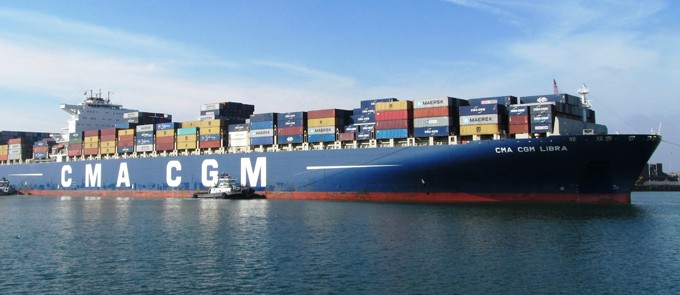
The CMA CGM Libra
For better fuel economy, the ship – like most freighters - does not have stabilisers unlike a cruise or passenger ship, or even older cargo ones. The engineers tell me the ship hull is designed so that stabilisers are not needed (flat bottom hull) yet it can roll in excess of 25 degrees either way in a storm when even the sailors can’t sleep. So far, the ship’s rough seas performance seems fine. I’ve rigged my own accelerometers out of ping pong balls for the ship isn’t rolling and pitching enough for them to work.
The heavy/bunker oil fuel tanks on the Libra are also equally impressive – 15,000 cubic meters or enough to fill 221 standard 40’ containers. As Russian bunker oil is of good quality and cheap, ships of the Pearl River Express (and probably also the Columbus Loop and other lines) periodically head for (Magadan) to refuel. Not the closest refuelling stop but the tanks are so big that the ships do not have to refuel (tanks are never completely filled anyway) for 3 months or more, and can travel across the north Pacific at least 5-6 times, on a not 100% full tank. All this while burning 300 tonnes daily at 40-41 km/h cruise speed.
Burning heavy oil means there is soot, something you’ll also see on cruise ships too when they are not in E.U. or U.S. territorial waters (or within a certain number of miles, 50-200?, of). The soot sometimes falls on the ship which is a source of grime and soot. Somethings it’s just a dry ash but sometimes it’s oily. No horde of seamen to keep it all clean as on a cruise ship (and sometimes, even they don’t).
The crew
CMA CGM crews its ships well with more officers than some. The officer list consists of the Captain a.k.a. master, the Chief Officer (a.k.a. chief mate), 2 2nd Officers (we had 3 on this trip), a 3rd Officer (the one who does the paperwork and is primarily in charge of safety and, oddly, the one to take command of the vessel should both the Captain and chief mate become incapacitated), the Chief Engineer (just about the same in rank to the Captain) and the 2nd, 3rd and 4th Engineers, Electrician (necessary for the circuits onboard ship), a Reefer man (electrician in waiting and not officially an officer) whose sole job is to check that the reefers maintain temperature (I’ve heard tolerance is +/- 0.5-1 degree C) and fix them if not, and for this voyage a cadet electrician.
If you wanted to know what the officers do, a sailor friend of mine who is now a master said, “The (captain) makes all the decisions, the (chief officer) runs the ship, the (second officer) steers the ship and the (third officer) does all the paperwork.”
Currently, the profession is still predominantly male domain though some countries such as Croatia apparently have a significant proportion of women in marine academies. Croatia however does have an extensive coastal ferry system which may lend itself to daily or overnight rotations.
The crewman are the Bosun (chief crewman), Electrical Fitter, Deck Fitter, 3 each of Able and Ordinary seaman (the sailors) and 2 Oilers (engine room crew), with the Chief Cook and Messman (a.k.a. steward), for a total of 13 rounding up the complement for a total of 24 officers and crew ordinarily. There are cabins for 16 Crew members which indicates how lean crewing has become. The ship still has designated cabin listings for Petty Officer, Motorman and Mechanic but their roles are absorbed or redundant.
Crew accommodation is generous – partly due to the space resulting from the required height of the accommodation for the bridge view - but organised by hierarchy. The Captain and Chief Engineer have the best cabins, with a large day/office and bed room suite each on the deck below the bridge (G deck) which also houses the administrative office and archive room for charts and logs. They have mounted desktop computers and I am sure they can monitor the ship, engine and all systems from there as well as do their paperwork. There is a designated cabin for a pilot probably just for the Suez and Panama canal transits. There are a couple of small cabins on the F deck, where the passenger cabins are located, for extra officers and cadets with one labelled for the “spare officer” and the other “supercargo”. Empty passenger cabins are also used for newly-boarding officers when there’s an overlap in rotation.
E deck is where most of the remaining officers are accommodated, with D and C deck for the crew – all have relatively-spacious individual cabins with windows and private bathrooms. C deck also houses the pool and palestra (the term “gymnasium” should not be used as there is no nakedness as the Greek-derived name implies), and the Officer lounge. The officers’ lounge is connected to the mess on B deck by a spiral stair case.
The galley is inbetween the two messes (crew lounge is located adjacent to the crew mess) and a spiral staircase leads down from there to A deck where the food and drinks stores are located, as are general laundry facilities. U or upper deck is the main deck and has the crew change room as well as the ship’s office. Upper deck is so named as there are at least ten decks below; one for every 8’6” of standard container height.
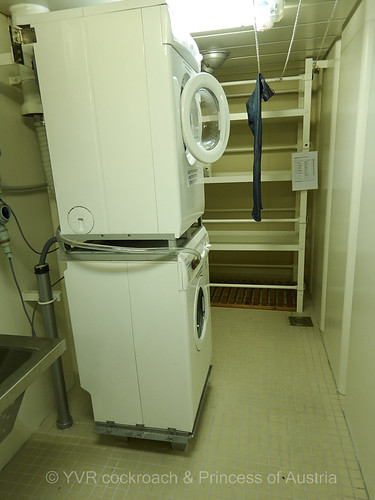 by
by
Laundry room on F deck. Reluctantly shared by the Captain and Chief Engineer with the passengers
A surprising number of laundry machine pairs for personal use are available. There’s one on F deck for the captain and chief engineer (as well as passengers), 3 on E deck and one on D deck. I think the captain and chief engineer resent passengers. The ship’s laundry is a separate facility with, presumably, a machine dedicated to dirty coveralls.
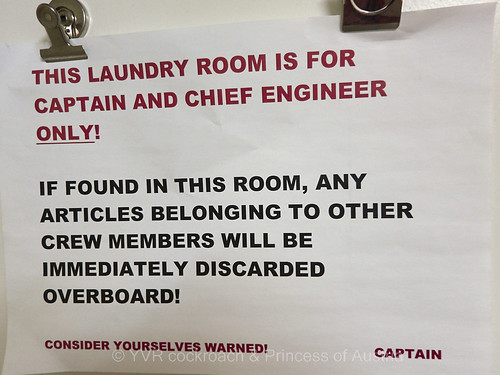 They resent us by
They resent us by
Working conditions aren’t too bad with most of the crew having 12 hour days and a solid 12 hours between shifts, though the Able Seamen may have the same shifts as the 2nd officers (4 on, 8 off). The Messman has longer days, starting at 0600 and ending at 1930 but he also has 3 hours of breaks inbetween.
 Built by Hyundai by yvrcockroach, maybe even made of old Ponys and Excels
Built by Hyundai by yvrcockroach, maybe even made of old Ponys and ExcelsSimply put, the CMA CGM Libra is huge, as are her 8 sister ships. Built by Hyundai and delivered in 2010, she is just about 364m (1,200’) long, 45.6m (150’) wide with a draft of some 15.5m and rated at 11,388 TEUs, though that is almost half the size of the newest container ships (additions to the CMA CGM fleet since include the newly-delivered China-built CMA CGM Benjamin Franklin (~18,000 TEUs) with CMA CGM Kerguelen and Georg Forster (above 17,000 TEU) and CMA CGM Marco Polo, Alexander von Humboldt and Jules Verne (16,000 TEUs), all of which have been delivered in the past 3 years. Some in the Maersk Line are even larger.
Despite her mid size, the Libra is as long as the world's largest cruise ship, RCI's Oasis class, with a beam just a couple of metres shy.
In most of her 16 forward hold halves, the Libra can stack 40’ containers up to 10 high – so that’s 85’ in depth and 16 abreast (over 128’ in hold width). Once the 32 tonne deck plates (weight of 16 average cars each) have been put in place (to prevent flooding) – 4 for half hold, 8 for each hold - the Libra can hold containers 18 abreast above deck and up to 8 high near and behind the accommodation, (6 high forward to facilitate forward view from the bridge). 45’ containers can only be stacked from the 4th level above deck and up. The ship weighs some 40,000 tonnes empty and has a maximum weight of 130,000+ tonnes so it can carry some 90,000 tonnes of cargo and fuel. By comparison, cruise ships displace much less and their tonnage is calculated on volume. I estimate that if you assume each cruise ship passenger weighs 300 lbs with bags, 1,000 only make up the weight of 4-5 fully-loaded 40’ containers. Add 2-3 containers of staff for every 1,000 passenger.

The CMA CGM Libra
For better fuel economy, the ship – like most freighters - does not have stabilisers unlike a cruise or passenger ship, or even older cargo ones. The engineers tell me the ship hull is designed so that stabilisers are not needed (flat bottom hull) yet it can roll in excess of 25 degrees either way in a storm when even the sailors can’t sleep. So far, the ship’s rough seas performance seems fine. I’ve rigged my own accelerometers out of ping pong balls for the ship isn’t rolling and pitching enough for them to work.
The heavy/bunker oil fuel tanks on the Libra are also equally impressive – 15,000 cubic meters or enough to fill 221 standard 40’ containers. As Russian bunker oil is of good quality and cheap, ships of the Pearl River Express (and probably also the Columbus Loop and other lines) periodically head for (Magadan) to refuel. Not the closest refuelling stop but the tanks are so big that the ships do not have to refuel (tanks are never completely filled anyway) for 3 months or more, and can travel across the north Pacific at least 5-6 times, on a not 100% full tank. All this while burning 300 tonnes daily at 40-41 km/h cruise speed.
Burning heavy oil means there is soot, something you’ll also see on cruise ships too when they are not in E.U. or U.S. territorial waters (or within a certain number of miles, 50-200?, of). The soot sometimes falls on the ship which is a source of grime and soot. Somethings it’s just a dry ash but sometimes it’s oily. No horde of seamen to keep it all clean as on a cruise ship (and sometimes, even they don’t).
The crew
CMA CGM crews its ships well with more officers than some. The officer list consists of the Captain a.k.a. master, the Chief Officer (a.k.a. chief mate), 2 2nd Officers (we had 3 on this trip), a 3rd Officer (the one who does the paperwork and is primarily in charge of safety and, oddly, the one to take command of the vessel should both the Captain and chief mate become incapacitated), the Chief Engineer (just about the same in rank to the Captain) and the 2nd, 3rd and 4th Engineers, Electrician (necessary for the circuits onboard ship), a Reefer man (electrician in waiting and not officially an officer) whose sole job is to check that the reefers maintain temperature (I’ve heard tolerance is +/- 0.5-1 degree C) and fix them if not, and for this voyage a cadet electrician.
If you wanted to know what the officers do, a sailor friend of mine who is now a master said, “The (captain) makes all the decisions, the (chief officer) runs the ship, the (second officer) steers the ship and the (third officer) does all the paperwork.”
Currently, the profession is still predominantly male domain though some countries such as Croatia apparently have a significant proportion of women in marine academies. Croatia however does have an extensive coastal ferry system which may lend itself to daily or overnight rotations.
The crewman are the Bosun (chief crewman), Electrical Fitter, Deck Fitter, 3 each of Able and Ordinary seaman (the sailors) and 2 Oilers (engine room crew), with the Chief Cook and Messman (a.k.a. steward), for a total of 13 rounding up the complement for a total of 24 officers and crew ordinarily. There are cabins for 16 Crew members which indicates how lean crewing has become. The ship still has designated cabin listings for Petty Officer, Motorman and Mechanic but their roles are absorbed or redundant.
Crew accommodation is generous – partly due to the space resulting from the required height of the accommodation for the bridge view - but organised by hierarchy. The Captain and Chief Engineer have the best cabins, with a large day/office and bed room suite each on the deck below the bridge (G deck) which also houses the administrative office and archive room for charts and logs. They have mounted desktop computers and I am sure they can monitor the ship, engine and all systems from there as well as do their paperwork. There is a designated cabin for a pilot probably just for the Suez and Panama canal transits. There are a couple of small cabins on the F deck, where the passenger cabins are located, for extra officers and cadets with one labelled for the “spare officer” and the other “supercargo”. Empty passenger cabins are also used for newly-boarding officers when there’s an overlap in rotation.
E deck is where most of the remaining officers are accommodated, with D and C deck for the crew – all have relatively-spacious individual cabins with windows and private bathrooms. C deck also houses the pool and palestra (the term “gymnasium” should not be used as there is no nakedness as the Greek-derived name implies), and the Officer lounge. The officers’ lounge is connected to the mess on B deck by a spiral stair case.
The galley is inbetween the two messes (crew lounge is located adjacent to the crew mess) and a spiral staircase leads down from there to A deck where the food and drinks stores are located, as are general laundry facilities. U or upper deck is the main deck and has the crew change room as well as the ship’s office. Upper deck is so named as there are at least ten decks below; one for every 8’6” of standard container height.
 by
by Laundry room on F deck. Reluctantly shared by the Captain and Chief Engineer with the passengers
A surprising number of laundry machine pairs for personal use are available. There’s one on F deck for the captain and chief engineer (as well as passengers), 3 on E deck and one on D deck. I think the captain and chief engineer resent passengers. The ship’s laundry is a separate facility with, presumably, a machine dedicated to dirty coveralls.
 They resent us by
They resent us by Working conditions aren’t too bad with most of the crew having 12 hour days and a solid 12 hours between shifts, though the Able Seamen may have the same shifts as the 2nd officers (4 on, 8 off). The Messman has longer days, starting at 0600 and ending at 1930 but he also has 3 hours of breaks inbetween.
Last edited by YVR Cockroach; Jun 19, 2016 at 3:40 pm
#3
FlyerTalk Evangelist
Original Poster
Join Date: Nov 1999
Programs: FB Silver going for Gold
Posts: 21,792
Day 1 – March 9th, HIT9, Hong Kong (position is ~0730-0900 local/ship time)
Day 1 – March 9th, HIT9, Hong Kong (position is ~0730-0900 local/ship time)
I would have started with Day 0 but boarding was delayed a day due to late arrival of the ship. I had kept in contact with the Line’s H.K. operations people and the shipping agent. The former must work long hours as they always tired. The previous day, the agent had offered and scheduled a courtesy pick up and the driver called us a few minutes ahead of pick up time to advise us to check out (we already had and were waiting). He arrived right on schedule in a small Chinese van.
Speaking to him, we found out that he knew the exact time to reach us as he had grown up and still lives in the MongKok/YauMaTei area. He is contracted by CMA CGM to primarily transport sailors between the airport/hotel and ships (some 50-90 a month for HongKong alone). It was a good thing having this service as he knew exactly where to go (try telling a HongKong taxi driver that you need to go to HIT 9 in TsingYi if you don’t speak Cantonese, or even if you do, and then getting past the gate) and knew the security detail so he didn’t have to stop (no admission otherwise without pass/ID) and knew his way to get around the stacks of containers to the ship, with fleets of trucks hauling containers to/from cranes for loading/unloading to the dock side. The ship was impressive by its size, and the gangway (a.k.a. accommodation ladder) was as high and steep as expected, but not the narrowness.
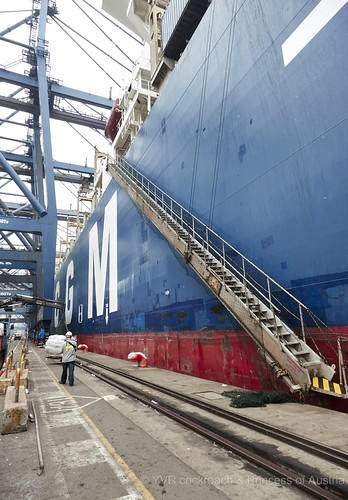 Accommodation ladder by yvrcockroach, on Flickr
Accommodation ladder by yvrcockroach, on Flickr
45-50' up the accommodation ladders is the main means of access. There is a pilot's door between the G and M on the ship hull, ~2m above maximum waterline, but you have to walk the hold deck under the man deck to get to the accommodation
Medical facilities or lack thereof.
By long-standing international maritime law or convention, ships have to carry a medical doctor onboard only if there are more than a dozen passengers. Freighters will carry a dozen passengers at most if any at all. To discourage the ill and unfit – while outright refusing those over 80, the line requires a medical examination statement, waiver forms including ones that certify you understand that there are no medical facilities onboard, have medical insurance that includes evacuation (supposedly that can cost 10s or even 100s of thousands), have to load and unload your own luggage, and agree to rules of conduct, and lastly, the discretion of the captain to permit you to board or not.
The first test is boarding. Other than a hatch or two accessible only by rope ladder for use by pilots or for rescue, the primary means of access is up the accommodation ladders on each side, from dock up to main deck. It’s a long way up, or down (45-50’ which is about ½ the hull’s height) and not only that but the ladder is somewhat rickety (lightweight metal as it is lifted down only for embarkation or disembarkation), narrow (only one person can pass) and often grimy/greasy.
The Libra does have a dispensary and sick room but beyond basic medicine and (industrial) first aid, not much else. We had a look through the window and noticed that there are two beds in there. They’re most likely for shipbound accidents that hopefully are in port or close to shore and casualties can be evacuated quickly. Helicopter operating range isn’t that far (two or three hundred miles at best).
As the ship’s crew was aware of our arrival, the driver waved and called out at a seaman on watch duty to come and help us with our bags (you are expected to carry your own and there is an actual weight allowance limit of 100 kg). The Austrian went up first and I followed closed behind up the narrow gangway stairs – so narrow that one cannot carry a bag by your side, some 80 steps and 50’ in all. It’s 13m (42’) from main deck to the bottom of the pilot door <between the G and M> and it must be another 2m from there to dock. The rails were grimy and greasy too so we had to try hard not to get our clothes dirty (Tip: embark and disembark wearing work coveralls and gloves, or at least your grimiest clothes). I carried my two backpacks up while the crewman carried the Austrian’s small roller suitcase on his shoulder.
The personnel about a ship are usually called Officers and Crew with Officers being the trained and licensed staff with the Crew being the sailors. I will use crew to refer to the collective and Crew to the sailors.
Dress onboard
It’s very casual, unless you want to stand out. The Officers and Crew seem to wear the company logoed coveralls while on duty only when the ship is docked. Otherwise only the technical people (engineers and electrician) and Crew doing grimy work wear coveralls while at sea. The First Officer occasionally chooses coveralls but the sailing officers and the captain dress like they’re hanging around at home and not expecting anyone to drop by. Nothing’s remotely nautical. No spiffy uniforms (or if there are any, they’re rarely worn) other than the company-issued golf shirts and trousers and shorts and I think they wear these because it’s free and they don’t have to wear out their own clothes. Motley crew can only be a term originally ascribed to sailors and perfectly describes them. Think of clothes one wears at home while doing chores or hanging around on a summer day, or casually shopping on weekend day, and that’s what you see the officers and crew wear. Ill-fitting sweat pants, bright-coloured t-shirts and other clothes, hoodies with hoods up even if they never go outside (the Chief and Second engineers particularly). It’s a good idea not to wear your good clothes on board anyway as there’s an excellent chance of getting a grim or grease or even grimy grease or greasy grime stain especially if you’re outside. The crew have a change room on U deck, and are told not to wear their grubby boot above A deck. As a result you see them wearing rubber clogs inside the accommodation.
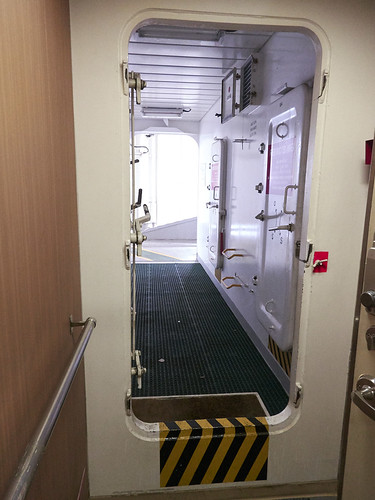 Main door by
Main door by
Doorway from the main deck into the accommodation

Ships' central office - main administrative office
The crewman on watch took down our passport information and wrote down names/passport number (tight ship security – it won’t be easy to stowaway if one got past dock gates) and we noticed the safety record which announced it’s been a long time since the last accident. That done, the ship’s officer on watch took us to the ship’s central office (one of at least three), which involved going through a watertight sealable high threshold door, where the Chief Officer (dressed in coveralls like everyone else) assigned us to cabin D. Fortunately there is an internal elevator (albeit small at 4 persons) to take us up the 6 floors. The external door is manual and locks while the car door is automatic. We were shown our room and left to settle in. While it seemed nice at first – two wide side windows and a narrower but taller window facing aft, we noticed that the bed was very small – two single (0.7m) mattresses put together (both narrower than twin mattresses). There was also only one immersion suit in the cabin and the biggest clue was a label above the inside door frame saying “CERTIFIED FOR 1 PERSON”.
After inquiring, and when the chief officer has some time to think about it, we were offered cabin C (a few clues that it is rated for 2 persons: “PASSENGER (C)(2-P)” outside and “CERTIFIED FOR 2 PERSONS” inside). This cabin, while only some 80 s.f. larger, was more spacious as there was no wide corridor (but that did also function as a huge bag storage space) and was very well lit with 2 wide side windows and 2 tall narrow windows facing forward. The beds – larger than a twin at 1.2m but narrower than the “double” in cabin D - are separated by the sitting area and can’t be moved together as the sofa, bed frames and 4 nightstand are all fixed in place. We also gained an additional window and a bank of desk drawers. The only towels one will get are a pair of bath and hand towels, and a shower mat. Full size bars of soap (presumably for all the grease and soot) and flat packs of water. The beds have duvets which are nice and facilitates tidiness (cabin beds are made daily – we asked Paul not to bother with this - but only cleaned and linens/towels changed weekly). There’s no actual room temperature control and the only method of keeping your room comfortable is controlling the amount of cooled air coming from the two ceiling vents (more than adequate) and keeping the toilet door open or closed (there’s an exhaust vent) and the door vent to the hallway, or leaving the windows open (not recommended). There is a heater in the bathroom but that’s it. There’s also a wall clock which is centrally set and will adjust for time change at the appointed time.
 Two person cabin
Two person cabin
Two person Cabin C
The desk has a passenger “familiarisation booklet” with safety instructions and a short “captain’s word” inside. I doubt if the captain or any of the officers, especially the designated officer in charge of passenger stay who has yet to identify himself after 2 weeks, have read it (“Ahh, it’s all some B.S. from Marseille.”).
We didn’t have keys either. Cabins and doors are all (or can be) locked by keys. Passenger cabins are supposed to have keys on the clothes hook (Cabin D did but the desk key didn’t work) but a previous occupant might have taken it when they left, and left one desk drawer locked too. It’d appear nobody locks their cabin doors so we did the same.
Passenger accommodation and ship life
All decks on the Libra’s accommodation have two exits, one each on starboard and port with stairs leading down to the main deck and up to the bridge. In additional to the internal elevator, there is also an internal stair case which is rather steep and narrow (good as you can haul yourself up with both hands) and, at 16 steps on 2 flights per deck, would appear to indicate that each deck almost matches the height of an overheight container.
Passenger cabin sizes, all 5 of them rated for a total of 7 passengers, vary on the Libra, but are spatially generous. The two 2-person cabins (A and C – mirrors of each other) are large at around 380 s.f. with two of the single passenger cabins (D and E – again mirrors of each other) being around 300 s.f. The last one, B is similar in size to D and E except it faces the front of the ship with no side window and only has 2 tall narrow windows so it may be a bit dark if containers are stacked high. All three would still be very generous in space for a solo traveller (or a couple if the beds were wide enough). There’s lots of room in all cabins with a desk with lamp and overhead storage, a small refrigerator, underbed storage drawers and 2 doored nightstands per bed, wardrobe (bottom is filled by the immersion suit package) and a sofa, 2 armchairs and coffee table - why a 5-person seating in a 1 or 2 person cabin, I don’t know but it is welcome. There’s laminate oak panelling everywhere and mainly blue furniture. The bathroom is small, very austere and occupies no more than 40 s.f. (still larger than some cruise ships). No vacuum flush toilets as sewer volume is not a big issue with only 28 souls onboard (39 max), a shower stall (curtains too short – who designed this?), drying line and sink with a medicine cabinet – no bathtubs on this tub. Functional but short on elegance. Surprisingly, light bulbs are all low-wattage (60W) incandescent (there are CFLs in other parts of the ship) so it can be a bit dim. Unlike a cruise ship, the cabin has a lot of electrical outlets. A total of 6 at the desk and one by each bed, in addition to the one for the fridge (and one in the bathroom). They’re capable of supporting a kettle too. There wasn’t one but on request, the Messman brought us one and 2 mugs.
Being a real ship, everything is fastened in place (drawers have catches to prevent opening and closing with pitch and roll and wardrobe doors have very strong magnets) or can be. Cables are in place to hold the unbolted furniture in place during rough seas.
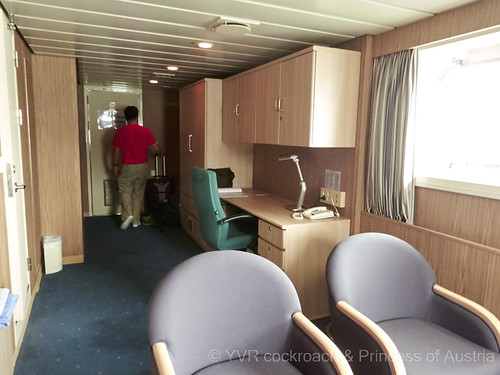 Cabin D by yvrcockroach
Cabin D by yvrcockroach
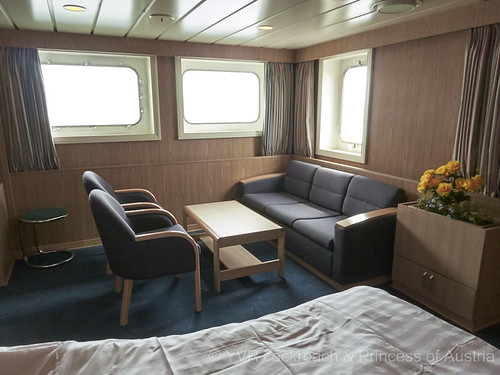 Single passenger Cabin D
Single passenger Cabin D
Single Passenger cabin Cabin D - starboard aft-facing
Cabin Guide
Just in case anyone wants to book on the Libra of sister ships Lyra, Centaurus, Leo, Andromeda, Cassiopeia, Gemini, Aquila and Pegasus (there might be one other, you'll know from the themed name):
Cabin A and C are the 2 double passenger berths and are mirrors of each other. Disadvantage is being out on the side with the most up and down movement when the ship rolls. Advantage is lots of window and obstructed side view if containers are stacked 7 or 8 high upfront.
Cabin D and E are the rear-facing & side window single passenger cabins. Due to asymmetry in the ship's accommodation, E is smaller than D (by about ~40-60 .f.). Still comfortable but smaller. E also has 2 rear-facing windows vs D's one, both have 2 side windows.
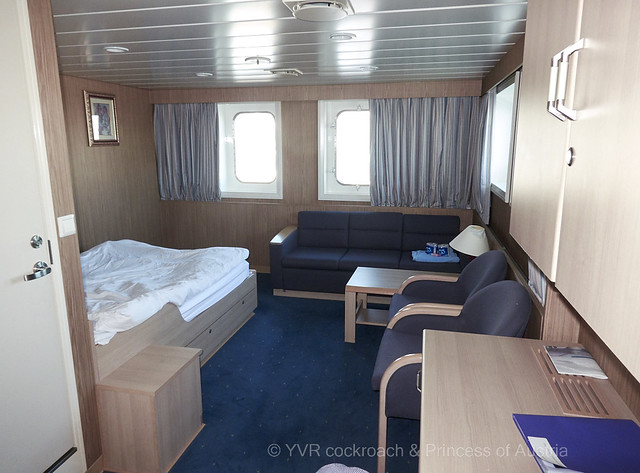
Cabin E vs....
 by
by
Cabin D
Cabin B is a more central forward-facing cabin. Very nicely arranged but only has two forward facing narrow windows. It'll get a bit dark if containers are stacked 7 or 8 high above deck.
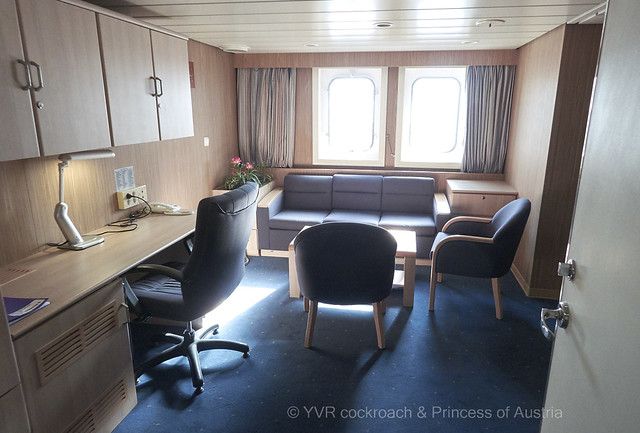 by
by
Living room of Cabin B - bedroom to the right side
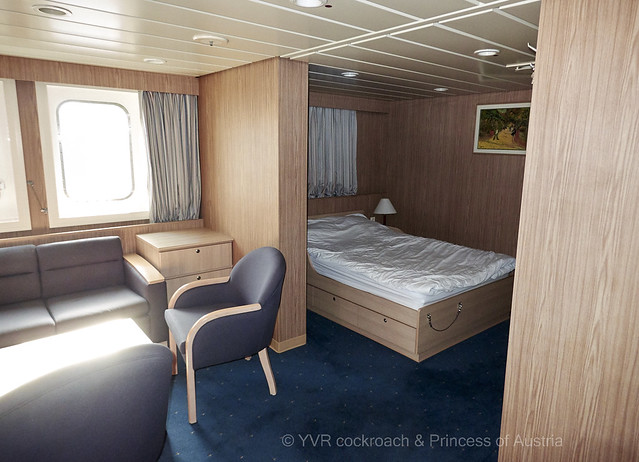 by
by
Bedroom of Cabin B - no windows so rather dark
Windows are relatively small though our deck is well over 100’ above water, and very solid. The officers and crew seem to have the curtains drawn shut anyway. The small opening windows have 4 screw locks and two hinges while the larger ones have 9 locks and 3 hinges. No sliding glass doors (ill-fitting on some cruise ships) and absolutely no wind noise or air leakage.
Next to the hallway from us was the Passenger Lounge, which consisted of a sofa, love seat and 2 arm chairs (for the maximum of 7 passengers) and a TV. Someone had swiped the DVD player (leaving the box behind) and there were precious few books in the library and the only movies were some awful ones about baseball that even the crew wouldn’t watch. There was a small Sony stereo but there were no media or no radio signals. We never used the lounge as there were no other passengers and we didn’t feel a need to use the TV. Ironically there are probably stacks of TVs and other playback devices on the ship, inside containers.
 Passenger Lounge
Passenger Lounge
Passenger Lounge
What’s inside containers
As previously mentioned, pretty much anything and everything that will fit. The crew only has a general declaration and have no idea if it’s a truthful declaration or not. They have to be trusting and accept the shippers’ word. For customs purpose, containers are not locked with only a non-reusable band indicating whether it has been opened or not. . Also, containers may or may not have their true weight declared. I’ve seen photos of containers having fallen from cranes because they exceeded the crane’s capacity (containers are only attached by the 4 corner points when lifted) and a stacks of collapsed containers on ships. It’s remarkable when you think that a container or two in the hold could have up to 144 tonnes of other containers stacked above them.
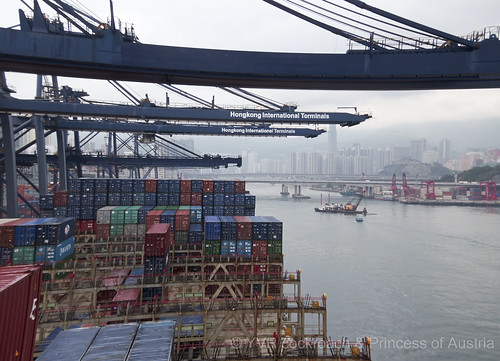 IMG_7695 1
IMG_7695 1
Loading at HIT 9, TsingYi, HongKong
After we had settled in, we went for lunch which, for passengers, is in the Officers’ Mess on B deck. There 3 tables: The large one is for the Captain, Electrician, Chief Officer, and 3rd Officer on one side and are faced respectively by the Chief, 2nd, 3rd and 4th Engineers. The second table is for two 2nd Officers, Reefer and Electrical Cadet who is due to be reefer on his next rotation. The third table is for passengers and could seat 7 – as could the second table - but we were the only two. Seating places are strictly adhered to so even if only the Electrician and the Second Officer who are seated facing away from each other were present, they would sit at their assigned places, backs to each other’s, even if engaged in conversation.
Onboard Dining
Food on board is usually determined by the nationality of the officers and crew, and the captain’s whims in particular. We had read that the cook on some German-officered ship liked to indulge the captain’s affection for rare horsemeat. We had booked on French-flagged and officered ships (presuming the food is better unless the captain has a hankering for bouchon cuisine from Lyon or a was a Provencal who loved pied paquets.) for another voyage but that came to naught. So did the sailing on a U.K. registered and officered ship (which could well have meant offal, black pudding and/or overcooked vegetables) unless we wanted to spend another 2 weeks in greater China and thus it was the Libra which is Maltese registered. We sort of dreaded Maltese cuisine (we had spent a week there in November) until I spoke with the Line’s H.K. office and found out that the officers were mostly Romanian…..
Romanians are perfectly capable of sea-faring despite no open sea access. They do have their major Black Sea port of Constanta with Tulcea a close second (3/4 of the Libra’s Romanians are from these two cities). I asked the Austrian how she would feel if the officers were Austrian (more familiar fare) and she said, “not very, there weren’t any container ships on the Danube the last time I checked”. Maybe not but the Baron von Trapp was a submarine captain and Danube monitors did have a role in mortaring in Belgrade in August 1914.
There’s a separate menu for officers and the Filipino crew nearly always getting rice for dinner and lunch (exception only when they get burgers). Officer lunch today consisted of soup (the daily soup is always served for lunch at dinner) self-served from a tureen on the cereal, jam and bread buffet, chicken, broccoli and fried rice for the main, and fresh fruit for dessert. I’ve never seen a paring knife on a dinner table setting before. Cooking is fairly light so dining is fairly healthy so one can consider it spa cuisine at sea though it certainly doesn’t pretend to be gourmet food. On the table are sliced tomatoes, baguettes (quite nice), sliced salami, and cheese (cheddar and something else, with butter/cream cheese occasionally). Lots of salad too: Iceberg (because it keeps for weeks) with sliced cucumbers and red peppers without variation for days. Other than for the BBQ, we have only had 3 ice creams and 3 prepared desserts (previously frozen) in 24 meals with everything else being fruit. The main course is plated and though you could always ask for more, no one ever does so there is a portion control.

Eat at these times or go hungry
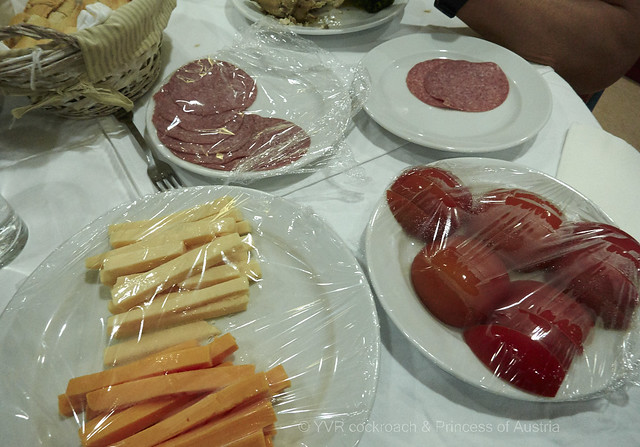
Constant staples on the table at lunch and dinner. That's the alternative to the menu de jour
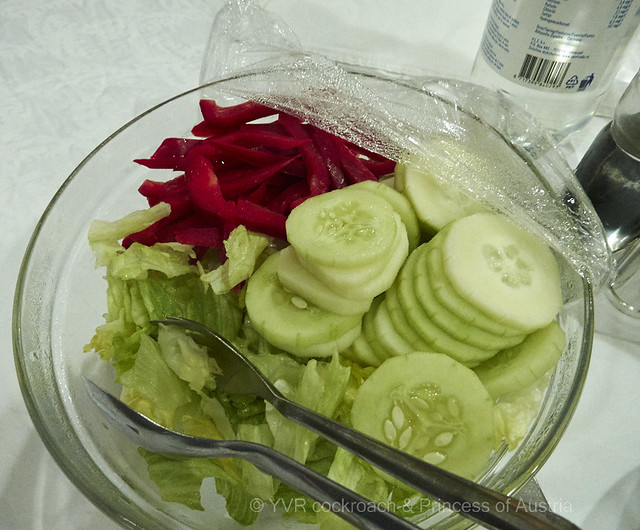
The salad composition didn't change until the last day, when green peppers substituted for the red ones
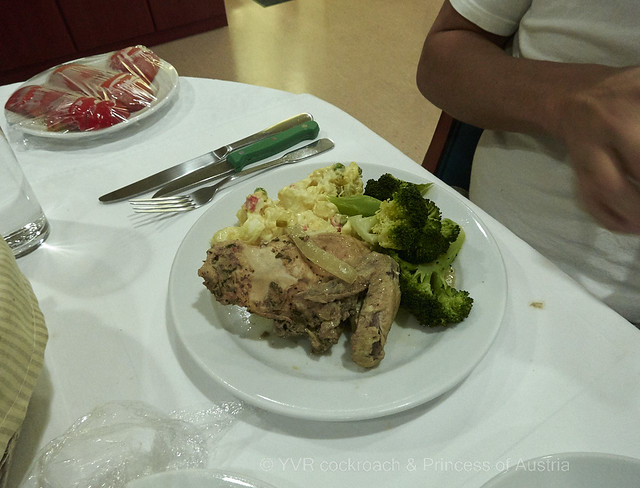 yvrcockroach
yvrcockroach
A typical main plate
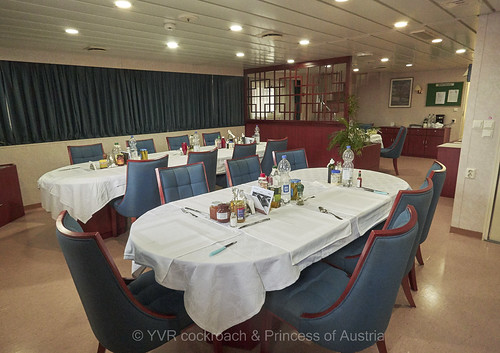 Officer's Mess
Officer's Mess
Officers' Mess
Food is prepared well ahead of time (generally for those about to go on duty) so depending on what it is and how it’s prepared, it may be served hot, warm, lukewarm or cool. For example, a stew with rice may be served hot but if it’s mashed potatoes instead, it may be cool. Fried food is hot if it’s off the griddle but otherwise cool. No heat lamps. One’s advised to go eat early.
The mess is attended to by a Messman (a.k.a. the steward) and the one on this ship was Paul from the Philippines (as with all the Crew and also the 2nd Officer). Paul had been sailing for 5 years and started in the galley (buffet salads) on Holland America cruise ships before moving to CMA CGM. Talking with him, I surmised that work conditions, accommodation (typically 2-4 in a cabin with bunk beds) and pay are fairer if not better on a container ship than on a cruise ship. He mentioned that on one of the cruise ships, the Crew had to work until 0300 and had to be on standby for work at 0600 during U.S. health inspection (and probably Norovirus outbreaks), and only getting paid for 11 hours. That and other issues led him (and other cruise ship workers) to CMA CGM (and other freight lines) where he is now on his 3rd 9-month contract.
 20160320 Libra menu by
20160320 Libra menu by
Sample menu
Various reports we’ve seen say that this is quite common as life onboard a freighter is much more pleasant compared to a cruise ship. Paul’s position’s responsibility includes serving the officers and keeping their mess, lounge and officer and passenger cabins clean, as well as helping the cook. Work days are long but there’s at least a long break between days. He also has his own cabin like all the other crewmen.
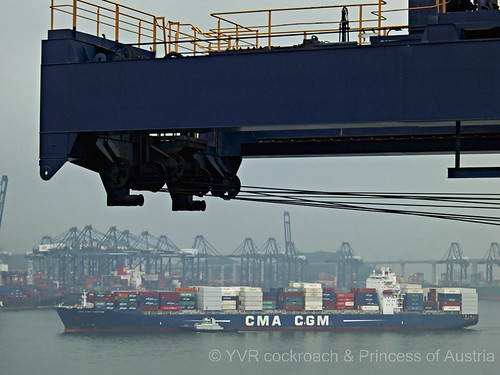 CMA CGM Tarpon in HongKong
CMA CGM Tarpon in HongKong
The CMA CGM Tarpon, which plies the south China - Eastern U.S. route, pulling into HIT9. Though only 3 years older than the Libra, it can carry fewer than half the containers.
After lunch, the 3rd Officer in charge of safety (who we later learned had embarked to begin his rotation only hours if not minutes before us) sat us down for a safety questionnaire outlining what signals are for what, where to report to/muster, what to bring and what one’s duties are (for passengers, it’s just “follow orders”). Going outside is forbidden (external doors are meant to be locked when in port) – almost a question of why in HongKong but perfectly clear in YanTian as is described later. That made for a boring afternoon as we could not go out to see the goings on of ship business.
We set sail at around 1700 from TsingYi with the crane arms all quickly raised for clearance after the last container was loaded, lines casted away and the two tug boats proceeded to turn the Libra around. With all the movement, hardly any of the officers came for dinner.
 by
by
Pulling away from HIT9
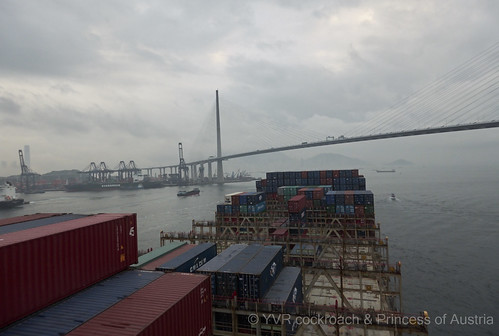 by
by
Heading out of harbour
 by
by
And going under one of the TsingYi bridges
Dinner was much the same except the promised roast pork belly was replaced with more chicken (we smelled it being cooked, so surmised the Filipino sailors must have eaten it). There’s only one choice so those with fussy diets may want to travel by other means. Meal times are very limited with breakfast served at 7-8h, lunch from 12-13h, and dinner from 18-19h. Dinner is an hour later on French-officered ships but reportedly an hour earlier on German-officered ones (“I don’t vant to order at 5, I vant to eat at five”. They probably eat breakfast at 0600 too.
So dinner is over and you’re back in your cabin by around 1900. The Officers also eat fast and the atmosphere is not particularly convivial, especially if you don’t speak Romanian (or probably even if you did – they’d just say less and head for their lounge faster).
No rest for the crew (almost for the entire week) as the next stop was in YanTian, the other side of the HongKong/KowLoon peninsula just 4 sailing hours away. We saw the lights of YanTian port around 2200 and saw the ship sail into port and dock, again assisted by tugs. The Libra has forward side thrusters but these probably are to assist in maneuvering rather than being able to self moor/unmoor.
The huge cranes of the port (more later) started to work almost straight away. We were asked for our passports earlier in the day but the officer in charge seemed to have forgotten and we could never find him. We tried to find him during the day but had no luck. He called after 2300 when the ship agent advised him to collect them for China clearance (and we had left the PRC just 60 hours before).
I would have started with Day 0 but boarding was delayed a day due to late arrival of the ship. I had kept in contact with the Line’s H.K. operations people and the shipping agent. The former must work long hours as they always tired. The previous day, the agent had offered and scheduled a courtesy pick up and the driver called us a few minutes ahead of pick up time to advise us to check out (we already had and were waiting). He arrived right on schedule in a small Chinese van.
Speaking to him, we found out that he knew the exact time to reach us as he had grown up and still lives in the MongKok/YauMaTei area. He is contracted by CMA CGM to primarily transport sailors between the airport/hotel and ships (some 50-90 a month for HongKong alone). It was a good thing having this service as he knew exactly where to go (try telling a HongKong taxi driver that you need to go to HIT 9 in TsingYi if you don’t speak Cantonese, or even if you do, and then getting past the gate) and knew the security detail so he didn’t have to stop (no admission otherwise without pass/ID) and knew his way to get around the stacks of containers to the ship, with fleets of trucks hauling containers to/from cranes for loading/unloading to the dock side. The ship was impressive by its size, and the gangway (a.k.a. accommodation ladder) was as high and steep as expected, but not the narrowness.
 Accommodation ladder by yvrcockroach, on Flickr
Accommodation ladder by yvrcockroach, on Flickr45-50' up the accommodation ladders is the main means of access. There is a pilot's door between the G and M on the ship hull, ~2m above maximum waterline, but you have to walk the hold deck under the man deck to get to the accommodation
Medical facilities or lack thereof.
By long-standing international maritime law or convention, ships have to carry a medical doctor onboard only if there are more than a dozen passengers. Freighters will carry a dozen passengers at most if any at all. To discourage the ill and unfit – while outright refusing those over 80, the line requires a medical examination statement, waiver forms including ones that certify you understand that there are no medical facilities onboard, have medical insurance that includes evacuation (supposedly that can cost 10s or even 100s of thousands), have to load and unload your own luggage, and agree to rules of conduct, and lastly, the discretion of the captain to permit you to board or not.
The first test is boarding. Other than a hatch or two accessible only by rope ladder for use by pilots or for rescue, the primary means of access is up the accommodation ladders on each side, from dock up to main deck. It’s a long way up, or down (45-50’ which is about ½ the hull’s height) and not only that but the ladder is somewhat rickety (lightweight metal as it is lifted down only for embarkation or disembarkation), narrow (only one person can pass) and often grimy/greasy.
The Libra does have a dispensary and sick room but beyond basic medicine and (industrial) first aid, not much else. We had a look through the window and noticed that there are two beds in there. They’re most likely for shipbound accidents that hopefully are in port or close to shore and casualties can be evacuated quickly. Helicopter operating range isn’t that far (two or three hundred miles at best).
As the ship’s crew was aware of our arrival, the driver waved and called out at a seaman on watch duty to come and help us with our bags (you are expected to carry your own and there is an actual weight allowance limit of 100 kg). The Austrian went up first and I followed closed behind up the narrow gangway stairs – so narrow that one cannot carry a bag by your side, some 80 steps and 50’ in all. It’s 13m (42’) from main deck to the bottom of the pilot door <between the G and M> and it must be another 2m from there to dock. The rails were grimy and greasy too so we had to try hard not to get our clothes dirty (Tip: embark and disembark wearing work coveralls and gloves, or at least your grimiest clothes). I carried my two backpacks up while the crewman carried the Austrian’s small roller suitcase on his shoulder.
The personnel about a ship are usually called Officers and Crew with Officers being the trained and licensed staff with the Crew being the sailors. I will use crew to refer to the collective and Crew to the sailors.
Dress onboard
It’s very casual, unless you want to stand out. The Officers and Crew seem to wear the company logoed coveralls while on duty only when the ship is docked. Otherwise only the technical people (engineers and electrician) and Crew doing grimy work wear coveralls while at sea. The First Officer occasionally chooses coveralls but the sailing officers and the captain dress like they’re hanging around at home and not expecting anyone to drop by. Nothing’s remotely nautical. No spiffy uniforms (or if there are any, they’re rarely worn) other than the company-issued golf shirts and trousers and shorts and I think they wear these because it’s free and they don’t have to wear out their own clothes. Motley crew can only be a term originally ascribed to sailors and perfectly describes them. Think of clothes one wears at home while doing chores or hanging around on a summer day, or casually shopping on weekend day, and that’s what you see the officers and crew wear. Ill-fitting sweat pants, bright-coloured t-shirts and other clothes, hoodies with hoods up even if they never go outside (the Chief and Second engineers particularly). It’s a good idea not to wear your good clothes on board anyway as there’s an excellent chance of getting a grim or grease or even grimy grease or greasy grime stain especially if you’re outside. The crew have a change room on U deck, and are told not to wear their grubby boot above A deck. As a result you see them wearing rubber clogs inside the accommodation.
 Main door by
Main door by Doorway from the main deck into the accommodation

Ships' central office - main administrative office
The crewman on watch took down our passport information and wrote down names/passport number (tight ship security – it won’t be easy to stowaway if one got past dock gates) and we noticed the safety record which announced it’s been a long time since the last accident. That done, the ship’s officer on watch took us to the ship’s central office (one of at least three), which involved going through a watertight sealable high threshold door, where the Chief Officer (dressed in coveralls like everyone else) assigned us to cabin D. Fortunately there is an internal elevator (albeit small at 4 persons) to take us up the 6 floors. The external door is manual and locks while the car door is automatic. We were shown our room and left to settle in. While it seemed nice at first – two wide side windows and a narrower but taller window facing aft, we noticed that the bed was very small – two single (0.7m) mattresses put together (both narrower than twin mattresses). There was also only one immersion suit in the cabin and the biggest clue was a label above the inside door frame saying “CERTIFIED FOR 1 PERSON”.
After inquiring, and when the chief officer has some time to think about it, we were offered cabin C (a few clues that it is rated for 2 persons: “PASSENGER (C)(2-P)” outside and “CERTIFIED FOR 2 PERSONS” inside). This cabin, while only some 80 s.f. larger, was more spacious as there was no wide corridor (but that did also function as a huge bag storage space) and was very well lit with 2 wide side windows and 2 tall narrow windows facing forward. The beds – larger than a twin at 1.2m but narrower than the “double” in cabin D - are separated by the sitting area and can’t be moved together as the sofa, bed frames and 4 nightstand are all fixed in place. We also gained an additional window and a bank of desk drawers. The only towels one will get are a pair of bath and hand towels, and a shower mat. Full size bars of soap (presumably for all the grease and soot) and flat packs of water. The beds have duvets which are nice and facilitates tidiness (cabin beds are made daily – we asked Paul not to bother with this - but only cleaned and linens/towels changed weekly). There’s no actual room temperature control and the only method of keeping your room comfortable is controlling the amount of cooled air coming from the two ceiling vents (more than adequate) and keeping the toilet door open or closed (there’s an exhaust vent) and the door vent to the hallway, or leaving the windows open (not recommended). There is a heater in the bathroom but that’s it. There’s also a wall clock which is centrally set and will adjust for time change at the appointed time.
 Two person cabin
Two person cabinTwo person Cabin C
The desk has a passenger “familiarisation booklet” with safety instructions and a short “captain’s word” inside. I doubt if the captain or any of the officers, especially the designated officer in charge of passenger stay who has yet to identify himself after 2 weeks, have read it (“Ahh, it’s all some B.S. from Marseille.”).
We didn’t have keys either. Cabins and doors are all (or can be) locked by keys. Passenger cabins are supposed to have keys on the clothes hook (Cabin D did but the desk key didn’t work) but a previous occupant might have taken it when they left, and left one desk drawer locked too. It’d appear nobody locks their cabin doors so we did the same.
Passenger accommodation and ship life
All decks on the Libra’s accommodation have two exits, one each on starboard and port with stairs leading down to the main deck and up to the bridge. In additional to the internal elevator, there is also an internal stair case which is rather steep and narrow (good as you can haul yourself up with both hands) and, at 16 steps on 2 flights per deck, would appear to indicate that each deck almost matches the height of an overheight container.
Passenger cabin sizes, all 5 of them rated for a total of 7 passengers, vary on the Libra, but are spatially generous. The two 2-person cabins (A and C – mirrors of each other) are large at around 380 s.f. with two of the single passenger cabins (D and E – again mirrors of each other) being around 300 s.f. The last one, B is similar in size to D and E except it faces the front of the ship with no side window and only has 2 tall narrow windows so it may be a bit dark if containers are stacked high. All three would still be very generous in space for a solo traveller (or a couple if the beds were wide enough). There’s lots of room in all cabins with a desk with lamp and overhead storage, a small refrigerator, underbed storage drawers and 2 doored nightstands per bed, wardrobe (bottom is filled by the immersion suit package) and a sofa, 2 armchairs and coffee table - why a 5-person seating in a 1 or 2 person cabin, I don’t know but it is welcome. There’s laminate oak panelling everywhere and mainly blue furniture. The bathroom is small, very austere and occupies no more than 40 s.f. (still larger than some cruise ships). No vacuum flush toilets as sewer volume is not a big issue with only 28 souls onboard (39 max), a shower stall (curtains too short – who designed this?), drying line and sink with a medicine cabinet – no bathtubs on this tub. Functional but short on elegance. Surprisingly, light bulbs are all low-wattage (60W) incandescent (there are CFLs in other parts of the ship) so it can be a bit dim. Unlike a cruise ship, the cabin has a lot of electrical outlets. A total of 6 at the desk and one by each bed, in addition to the one for the fridge (and one in the bathroom). They’re capable of supporting a kettle too. There wasn’t one but on request, the Messman brought us one and 2 mugs.
Being a real ship, everything is fastened in place (drawers have catches to prevent opening and closing with pitch and roll and wardrobe doors have very strong magnets) or can be. Cables are in place to hold the unbolted furniture in place during rough seas.
 Cabin D by yvrcockroach
Cabin D by yvrcockroach Single passenger Cabin D
Single passenger Cabin DSingle Passenger cabin Cabin D - starboard aft-facing
Cabin Guide
Just in case anyone wants to book on the Libra of sister ships Lyra, Centaurus, Leo, Andromeda, Cassiopeia, Gemini, Aquila and Pegasus (there might be one other, you'll know from the themed name):
Cabin A and C are the 2 double passenger berths and are mirrors of each other. Disadvantage is being out on the side with the most up and down movement when the ship rolls. Advantage is lots of window and obstructed side view if containers are stacked 7 or 8 high upfront.
Cabin D and E are the rear-facing & side window single passenger cabins. Due to asymmetry in the ship's accommodation, E is smaller than D (by about ~40-60 .f.). Still comfortable but smaller. E also has 2 rear-facing windows vs D's one, both have 2 side windows.

Cabin E vs....
 by
by Cabin D
Cabin B is a more central forward-facing cabin. Very nicely arranged but only has two forward facing narrow windows. It'll get a bit dark if containers are stacked 7 or 8 high above deck.
 by
by Living room of Cabin B - bedroom to the right side
 by
by Bedroom of Cabin B - no windows so rather dark
Windows are relatively small though our deck is well over 100’ above water, and very solid. The officers and crew seem to have the curtains drawn shut anyway. The small opening windows have 4 screw locks and two hinges while the larger ones have 9 locks and 3 hinges. No sliding glass doors (ill-fitting on some cruise ships) and absolutely no wind noise or air leakage.
Next to the hallway from us was the Passenger Lounge, which consisted of a sofa, love seat and 2 arm chairs (for the maximum of 7 passengers) and a TV. Someone had swiped the DVD player (leaving the box behind) and there were precious few books in the library and the only movies were some awful ones about baseball that even the crew wouldn’t watch. There was a small Sony stereo but there were no media or no radio signals. We never used the lounge as there were no other passengers and we didn’t feel a need to use the TV. Ironically there are probably stacks of TVs and other playback devices on the ship, inside containers.
 Passenger Lounge
Passenger LoungePassenger Lounge
What’s inside containers
As previously mentioned, pretty much anything and everything that will fit. The crew only has a general declaration and have no idea if it’s a truthful declaration or not. They have to be trusting and accept the shippers’ word. For customs purpose, containers are not locked with only a non-reusable band indicating whether it has been opened or not. . Also, containers may or may not have their true weight declared. I’ve seen photos of containers having fallen from cranes because they exceeded the crane’s capacity (containers are only attached by the 4 corner points when lifted) and a stacks of collapsed containers on ships. It’s remarkable when you think that a container or two in the hold could have up to 144 tonnes of other containers stacked above them.
 IMG_7695 1
IMG_7695 1Loading at HIT 9, TsingYi, HongKong
After we had settled in, we went for lunch which, for passengers, is in the Officers’ Mess on B deck. There 3 tables: The large one is for the Captain, Electrician, Chief Officer, and 3rd Officer on one side and are faced respectively by the Chief, 2nd, 3rd and 4th Engineers. The second table is for two 2nd Officers, Reefer and Electrical Cadet who is due to be reefer on his next rotation. The third table is for passengers and could seat 7 – as could the second table - but we were the only two. Seating places are strictly adhered to so even if only the Electrician and the Second Officer who are seated facing away from each other were present, they would sit at their assigned places, backs to each other’s, even if engaged in conversation.
Onboard Dining
Food on board is usually determined by the nationality of the officers and crew, and the captain’s whims in particular. We had read that the cook on some German-officered ship liked to indulge the captain’s affection for rare horsemeat. We had booked on French-flagged and officered ships (presuming the food is better unless the captain has a hankering for bouchon cuisine from Lyon or a was a Provencal who loved pied paquets.) for another voyage but that came to naught. So did the sailing on a U.K. registered and officered ship (which could well have meant offal, black pudding and/or overcooked vegetables) unless we wanted to spend another 2 weeks in greater China and thus it was the Libra which is Maltese registered. We sort of dreaded Maltese cuisine (we had spent a week there in November) until I spoke with the Line’s H.K. office and found out that the officers were mostly Romanian…..
Romanians are perfectly capable of sea-faring despite no open sea access. They do have their major Black Sea port of Constanta with Tulcea a close second (3/4 of the Libra’s Romanians are from these two cities). I asked the Austrian how she would feel if the officers were Austrian (more familiar fare) and she said, “not very, there weren’t any container ships on the Danube the last time I checked”. Maybe not but the Baron von Trapp was a submarine captain and Danube monitors did have a role in mortaring in Belgrade in August 1914.
There’s a separate menu for officers and the Filipino crew nearly always getting rice for dinner and lunch (exception only when they get burgers). Officer lunch today consisted of soup (the daily soup is always served for lunch at dinner) self-served from a tureen on the cereal, jam and bread buffet, chicken, broccoli and fried rice for the main, and fresh fruit for dessert. I’ve never seen a paring knife on a dinner table setting before. Cooking is fairly light so dining is fairly healthy so one can consider it spa cuisine at sea though it certainly doesn’t pretend to be gourmet food. On the table are sliced tomatoes, baguettes (quite nice), sliced salami, and cheese (cheddar and something else, with butter/cream cheese occasionally). Lots of salad too: Iceberg (because it keeps for weeks) with sliced cucumbers and red peppers without variation for days. Other than for the BBQ, we have only had 3 ice creams and 3 prepared desserts (previously frozen) in 24 meals with everything else being fruit. The main course is plated and though you could always ask for more, no one ever does so there is a portion control.

Eat at these times or go hungry

Constant staples on the table at lunch and dinner. That's the alternative to the menu de jour

The salad composition didn't change until the last day, when green peppers substituted for the red ones
 yvrcockroach
yvrcockroachA typical main plate
 Officer's Mess
Officer's MessOfficers' Mess
Food is prepared well ahead of time (generally for those about to go on duty) so depending on what it is and how it’s prepared, it may be served hot, warm, lukewarm or cool. For example, a stew with rice may be served hot but if it’s mashed potatoes instead, it may be cool. Fried food is hot if it’s off the griddle but otherwise cool. No heat lamps. One’s advised to go eat early.
The mess is attended to by a Messman (a.k.a. the steward) and the one on this ship was Paul from the Philippines (as with all the Crew and also the 2nd Officer). Paul had been sailing for 5 years and started in the galley (buffet salads) on Holland America cruise ships before moving to CMA CGM. Talking with him, I surmised that work conditions, accommodation (typically 2-4 in a cabin with bunk beds) and pay are fairer if not better on a container ship than on a cruise ship. He mentioned that on one of the cruise ships, the Crew had to work until 0300 and had to be on standby for work at 0600 during U.S. health inspection (and probably Norovirus outbreaks), and only getting paid for 11 hours. That and other issues led him (and other cruise ship workers) to CMA CGM (and other freight lines) where he is now on his 3rd 9-month contract.
 20160320 Libra menu by
20160320 Libra menu by Sample menu
Various reports we’ve seen say that this is quite common as life onboard a freighter is much more pleasant compared to a cruise ship. Paul’s position’s responsibility includes serving the officers and keeping their mess, lounge and officer and passenger cabins clean, as well as helping the cook. Work days are long but there’s at least a long break between days. He also has his own cabin like all the other crewmen.
 CMA CGM Tarpon in HongKong
CMA CGM Tarpon in HongKongThe CMA CGM Tarpon, which plies the south China - Eastern U.S. route, pulling into HIT9. Though only 3 years older than the Libra, it can carry fewer than half the containers.
After lunch, the 3rd Officer in charge of safety (who we later learned had embarked to begin his rotation only hours if not minutes before us) sat us down for a safety questionnaire outlining what signals are for what, where to report to/muster, what to bring and what one’s duties are (for passengers, it’s just “follow orders”). Going outside is forbidden (external doors are meant to be locked when in port) – almost a question of why in HongKong but perfectly clear in YanTian as is described later. That made for a boring afternoon as we could not go out to see the goings on of ship business.
We set sail at around 1700 from TsingYi with the crane arms all quickly raised for clearance after the last container was loaded, lines casted away and the two tug boats proceeded to turn the Libra around. With all the movement, hardly any of the officers came for dinner.
 by
by Pulling away from HIT9
 by
by Heading out of harbour
 by
by And going under one of the TsingYi bridges
Dinner was much the same except the promised roast pork belly was replaced with more chicken (we smelled it being cooked, so surmised the Filipino sailors must have eaten it). There’s only one choice so those with fussy diets may want to travel by other means. Meal times are very limited with breakfast served at 7-8h, lunch from 12-13h, and dinner from 18-19h. Dinner is an hour later on French-officered ships but reportedly an hour earlier on German-officered ones (“I don’t vant to order at 5, I vant to eat at five”. They probably eat breakfast at 0600 too.
So dinner is over and you’re back in your cabin by around 1900. The Officers also eat fast and the atmosphere is not particularly convivial, especially if you don’t speak Romanian (or probably even if you did – they’d just say less and head for their lounge faster).
No rest for the crew (almost for the entire week) as the next stop was in YanTian, the other side of the HongKong/KowLoon peninsula just 4 sailing hours away. We saw the lights of YanTian port around 2200 and saw the ship sail into port and dock, again assisted by tugs. The Libra has forward side thrusters but these probably are to assist in maneuvering rather than being able to self moor/unmoor.
The huge cranes of the port (more later) started to work almost straight away. We were asked for our passports earlier in the day but the officer in charge seemed to have forgotten and we could never find him. We tried to find him during the day but had no luck. He called after 2300 when the ship agent advised him to collect them for China clearance (and we had left the PRC just 60 hours before).
Last edited by YVR Cockroach; Apr 23, 2016 at 5:51 pm Reason: photo addition, cabin guide
#5
FlyerTalk Evangelist
Original Poster
Join Date: Nov 1999
Programs: FB Silver going for Gold
Posts: 21,792
Day 2 – 10 March YanTian, GuangDong province, the People’s Republic of China
We had a good sleep on board and it was remarkably quiet given that huge containers were being moved around all night. We woke to see this activity and were somewhat astonished by the size and speed of the cranes – capable of moving 2 40-45’ container simultaneously – and the fleet of trucks moving containers into place. There were some 5 or 6 lanes of truck traffic. This went on all day until the ship cast off at almost 1800 so it was some 19 hours of busy work. No offer or option of going ashore was made. While we were in port during the day, at least 3 other huge container ships came into port and the docks have enough cranes (probably some 40-60) and space to sort and store tens of thousands of containers and tend to a dozen or so large ships. With most of what you buy and carried on these ships and made in southern China – ShenZhen in particular, it would make sense that YanTian is a major port. Too bad we didn’t get to see NanSha which probably ships everything made in GuangZhou (a.k.a. Canton).
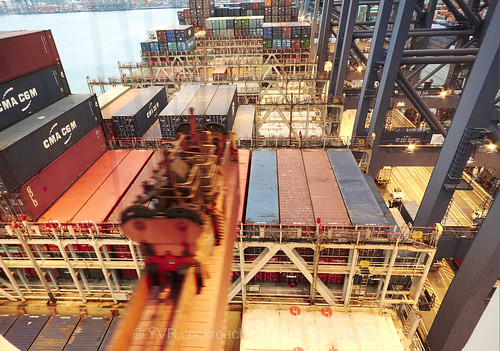 IMG_7760 by yvrcockroach, on Flickr
IMG_7760 by yvrcockroach, on Flickr
Early morning loading in YanTian. This had already been going on for 7 hours
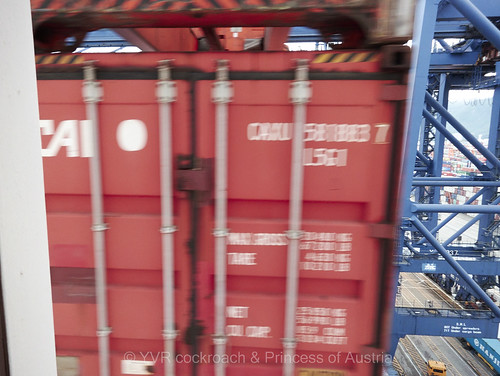 IMG_7855 1 by yvrcockroach, on Flickr
IMG_7855 1 by yvrcockroach, on Flickr
Remember the nghtmare distribution scene in Monster, Inc.?
Breakfast was early, just 0700-0800, and so we went, to an empty mess. The officers must have been too busy or too tired to eat but it seems to be like that most days as we very seldomly see anyone else. Breakfast is a simple affair with lots of cereal (nothing overtly sugared seemingly from all corners of the globe - Kellogg’s Corn Flakes from Belgium and Kellogg’s All Bran from Thailand, knock-off Weet-bix from Britain, knock-off Kroger shredded wheat), milk (and yogurt on request) is UHT and from Germany (and later in the voyage from Utah). Bread is either purchased at ports of call but seemingly baked onboard after a few days. Cooked breakfast is egg and sausage and/or bacon.
Back in our cabin, we opened the window to see outside and watch containers moving within 8-10’ of our window, and looked down some 134’ into the open empty hold immediately below our cabin.
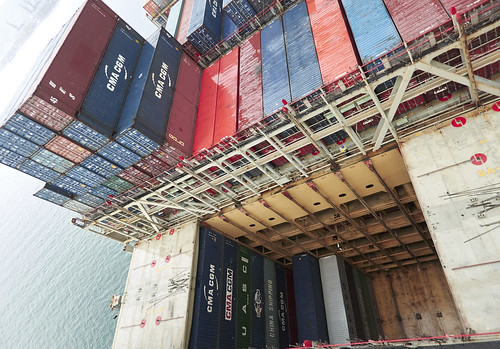 IMG_7802 by yvrcockroach, on Flickr
IMG_7802 by yvrcockroach, on Flickr
Loading of Bay B, Hold 8.
 Passing container lift by yvrcockroach, on Flickr
Passing container lift by yvrcockroach, on Flickr
Containers for Bay B, Hold 8 were moving less than 10' away from our cabin
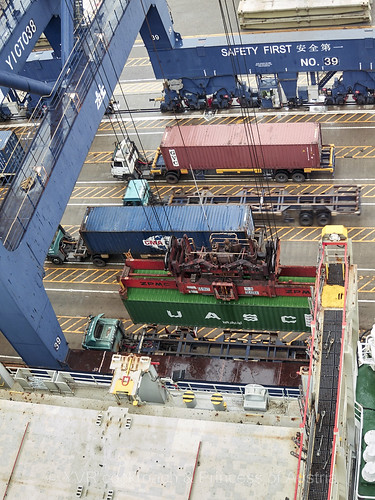 Waiting truck fleet by yvrcockroach, on Flickr
Waiting truck fleet by yvrcockroach, on Flickr
Fleets of trucks attend to the cranes to move containers on or away
With all the time, we also went to look at the recreational facilities. On C deck, there is an exercise room and a swimming pool opposite sides. I’ve read reports where officers from certain maritime countries with a fetish for fresh fish buy live fish from local fishermen and use the pool as a pantry. I don’t think I have to worry about that as far as Romanians are concerned but the pool still hasn’t been filled (the ocean is too cold and too rough perhaps and it is rather unattractively situated).
 Exercise room by yvrcockroach, on Flickr
Exercise room by yvrcockroach, on Flickr
Palestra of the Libra
On the other side is exercise room. Unfortunately it is somewhat poorly equipped with a couple of ratty, poorly-built Korean exercise cycles (the ship was apparently turnkey delivered from Korea other than artwork reproductions and CMA CGM posters of its ships), a running belt that was apparently purchased in the U.S. as it has a huge voltage transformer, a cheap shock absorber-based rowing machine, a punch bag, a poorly-made Weider-branded weight station and free weights all surrounding a table tennis table. The most interesting is that in addition to the purpose-made weights, the crew have also improvised with using scrap hardware from the ship. Sailors are often a buffed bunch and it’s no mystery when you figure what recreation they have available.
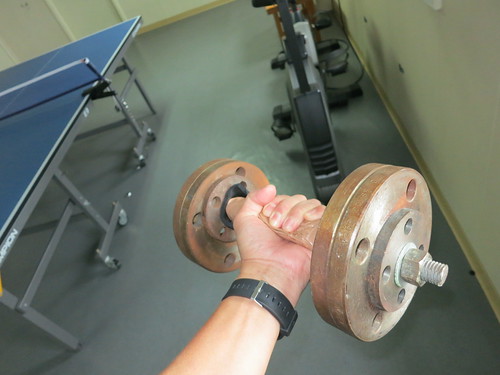 Makeshift dumbbell by yvrcockroach
Makeshift dumbbell by yvrcockroach
No running on the main deck due to wind and rough seas but also because you have to wear safety equipment, the same as you need in the engine room minus hearing protection, to be outside.
Whenever the ship is in port, the very few officers you see in the dining room will just say, “main plate please” to the Messman. They are just eating to live and getting back to duty or sleeping.
The ship duly casted off so it was off we sailed just before dusk and seeing the fading glow of Shen Zhen and HongKong as we left. Casting off meant the ship moving away from dock (it takes quite a bit of energy to get the amount of mass going – 3 generators powering the bow thruster for one) and once sufficiently far away, two tugs work to turn the ship around so it can sail out. The mass is astonishing.
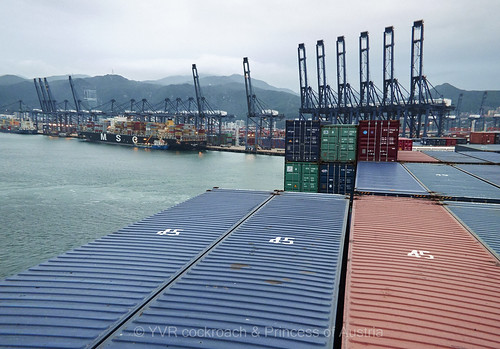 Leaving YanTian by yvrcockroach, on Flickr
Leaving YanTian by yvrcockroach, on Flickr
Pulling back way from YanTian terminal
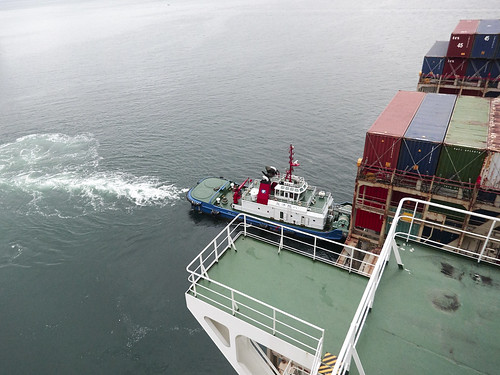 Tug at Yantian by yvrcockroach, on Flickr
Tug at Yantian by yvrcockroach, on Flickr
Two tug turning the stern around. One pushing, one pulling
Dinner was a beef goulash and a special treat of ice cream. We came to realise that a proper dessert is served every other dinner with ice cream (just vanilla or chocolate) served only on Thursday lunch.
We had a good sleep on board and it was remarkably quiet given that huge containers were being moved around all night. We woke to see this activity and were somewhat astonished by the size and speed of the cranes – capable of moving 2 40-45’ container simultaneously – and the fleet of trucks moving containers into place. There were some 5 or 6 lanes of truck traffic. This went on all day until the ship cast off at almost 1800 so it was some 19 hours of busy work. No offer or option of going ashore was made. While we were in port during the day, at least 3 other huge container ships came into port and the docks have enough cranes (probably some 40-60) and space to sort and store tens of thousands of containers and tend to a dozen or so large ships. With most of what you buy and carried on these ships and made in southern China – ShenZhen in particular, it would make sense that YanTian is a major port. Too bad we didn’t get to see NanSha which probably ships everything made in GuangZhou (a.k.a. Canton).
 IMG_7760 by yvrcockroach, on Flickr
IMG_7760 by yvrcockroach, on FlickrEarly morning loading in YanTian. This had already been going on for 7 hours
 IMG_7855 1 by yvrcockroach, on Flickr
IMG_7855 1 by yvrcockroach, on FlickrRemember the nghtmare distribution scene in Monster, Inc.?
Breakfast was early, just 0700-0800, and so we went, to an empty mess. The officers must have been too busy or too tired to eat but it seems to be like that most days as we very seldomly see anyone else. Breakfast is a simple affair with lots of cereal (nothing overtly sugared seemingly from all corners of the globe - Kellogg’s Corn Flakes from Belgium and Kellogg’s All Bran from Thailand, knock-off Weet-bix from Britain, knock-off Kroger shredded wheat), milk (and yogurt on request) is UHT and from Germany (and later in the voyage from Utah). Bread is either purchased at ports of call but seemingly baked onboard after a few days. Cooked breakfast is egg and sausage and/or bacon.
Back in our cabin, we opened the window to see outside and watch containers moving within 8-10’ of our window, and looked down some 134’ into the open empty hold immediately below our cabin.
 IMG_7802 by yvrcockroach, on Flickr
IMG_7802 by yvrcockroach, on FlickrLoading of Bay B, Hold 8.
 Passing container lift by yvrcockroach, on Flickr
Passing container lift by yvrcockroach, on FlickrContainers for Bay B, Hold 8 were moving less than 10' away from our cabin
 Waiting truck fleet by yvrcockroach, on Flickr
Waiting truck fleet by yvrcockroach, on FlickrFleets of trucks attend to the cranes to move containers on or away
With all the time, we also went to look at the recreational facilities. On C deck, there is an exercise room and a swimming pool opposite sides. I’ve read reports where officers from certain maritime countries with a fetish for fresh fish buy live fish from local fishermen and use the pool as a pantry. I don’t think I have to worry about that as far as Romanians are concerned but the pool still hasn’t been filled (the ocean is too cold and too rough perhaps and it is rather unattractively situated).
 Exercise room by yvrcockroach, on Flickr
Exercise room by yvrcockroach, on FlickrPalestra of the Libra
On the other side is exercise room. Unfortunately it is somewhat poorly equipped with a couple of ratty, poorly-built Korean exercise cycles (the ship was apparently turnkey delivered from Korea other than artwork reproductions and CMA CGM posters of its ships), a running belt that was apparently purchased in the U.S. as it has a huge voltage transformer, a cheap shock absorber-based rowing machine, a punch bag, a poorly-made Weider-branded weight station and free weights all surrounding a table tennis table. The most interesting is that in addition to the purpose-made weights, the crew have also improvised with using scrap hardware from the ship. Sailors are often a buffed bunch and it’s no mystery when you figure what recreation they have available.
 Makeshift dumbbell by yvrcockroach
Makeshift dumbbell by yvrcockroachNo running on the main deck due to wind and rough seas but also because you have to wear safety equipment, the same as you need in the engine room minus hearing protection, to be outside.
Whenever the ship is in port, the very few officers you see in the dining room will just say, “main plate please” to the Messman. They are just eating to live and getting back to duty or sleeping.
The ship duly casted off so it was off we sailed just before dusk and seeing the fading glow of Shen Zhen and HongKong as we left. Casting off meant the ship moving away from dock (it takes quite a bit of energy to get the amount of mass going – 3 generators powering the bow thruster for one) and once sufficiently far away, two tugs work to turn the ship around so it can sail out. The mass is astonishing.
 Leaving YanTian by yvrcockroach, on Flickr
Leaving YanTian by yvrcockroach, on FlickrPulling back way from YanTian terminal
 Tug at Yantian by yvrcockroach, on Flickr
Tug at Yantian by yvrcockroach, on FlickrTwo tug turning the stern around. One pushing, one pulling
Dinner was a beef goulash and a special treat of ice cream. We came to realise that a proper dessert is served every other dinner with ice cream (just vanilla or chocolate) served only on Thursday lunch.
Last edited by YVR Cockroach; Mar 26, 2016 at 11:50 pm Reason: Photo ddition
#6
Join Date: Apr 2012
Location: ORD
Programs: United 100K, Etihad Gold, Marriot Platinum, Hilton Gold
Posts: 578
cool report - Note that your sleeping quarters are probably 4 times bigger than what they gave us when I worked offshore, and they crammed 4 of us in that space. good luck
#8
A FlyerTalk Posting Legend
Join Date: May 2002
Location: YEG
Programs: HH Silver
Posts: 56,438






















 !
! 
